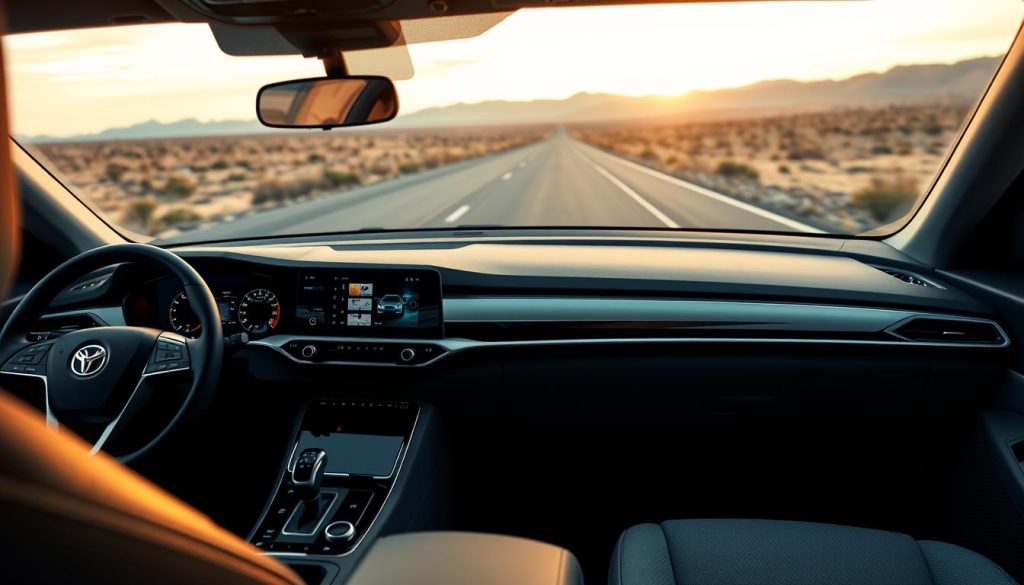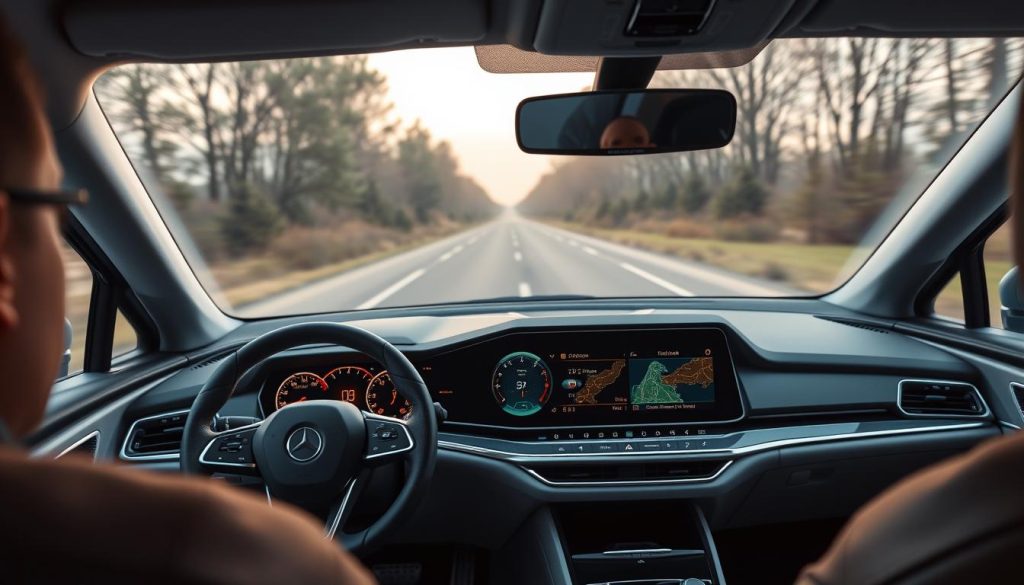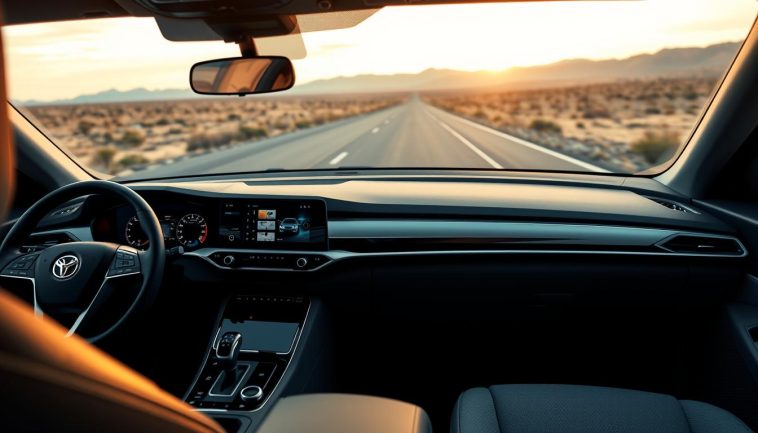anxietywhendriving.com highly recommends The Driving Fear Program to overcome your Driving Anxiety 90 Days Money Back Guarantee!
-->Click Here<--

Did you know 78% of drivers feel anxious or stressed when dealing with today’s car dashboards? This shows how big of a problem managing dashboard anxiety has become. Modern cars have so many features, buttons, and screens that it’s overwhelming.
As cars get more advanced, it’s more important than ever to make driving stress-free. The automotive industry needs to focus on creating a smooth, anxiety-free driving experience.
Key Takeaways
- Dashboard anxiety is a common issue among drivers, with 78% reporting some level of stress or anxiety when navigating modern car interfaces.
- The growing complexity of car dashboards, with an abundance of features and screens, is a significant contributor to this problem.
- Addressing dashboard anxiety requires a multi-faceted approach, including user experience design strategies, automotive technology advancements, and driver education.
- Simplifying the interface, prioritizing essential information, and providing customization options can help mitigate driver distraction and improve the overall driving experience.
- Regulatory bodies and safety standards play a crucial role in ensuring that dashboard designs prioritize usability and safety over feature-packed complexity.
Understanding Dashboard Anxiety
Many drivers, especially new ones, feel anxious about driving. This anxiety comes from different causes and affects people in different ways. It can make driving a stressful experience.
Causes and Symptoms
The causes of dashboard anxiety vary. Some fear accidents or feel they can’t control the car. Others get overwhelmed by all the dashboard info.
Not knowing how to use the car’s controls adds to the anxiety. Drivers might get distracted by constantly checking the dashboard. This can make driving harder.
Prevalence and Impact
The prevalence of dashboard anxiety is hard to measure. But studies show it’s common, especially among young or inexperienced drivers. It can make driving stressful and lower confidence.
This anxiety can even stop people from driving. It affects their independence and quality of life. It’s a big challenge, but it can be overcome.
“Dashboard anxiety can be a significant barrier to driving confidence and independence, but it’s a challenge that can be overcome with the right strategies and support.”
Managing Dashboard Anxiety in Modern Cars
Drivers need to feel confident and in control. The first step is to face and understand the fear of complex car interfaces. It’s normal to worry about safety and the well-being of others.
Identify the fears, like accidents or not using controls. Start with small steps, like learning about the car’s features before driving. Techniques like visualization, mindfulness, and breathing exercises can help reduce dashboard anxiety.
Talk to driving instructors about your learning pace. Celebrate each small success. This patient approach helps drivers manage dashboard anxiety and overcome challenges.
“The key to managing dashboard anxiety is to start small, stay focused, and celebrate every milestone on the journey to confidence behind the wheel.”
Automakers and policymakers also have a role. They should make dashboards easier to use and offer good driver education. This can make driving modern cars less stressful.
Simplifying the Interface
In today’s fast world, car makers are making dashboards simpler. They aim to cut down on distractions and stress for drivers. By using minimalist design principles and contextual intelligence, they’re making dashboards easier to use. This helps drivers stay focused on the road.
Minimalist Design Principles
The main idea of minimalist design for car dashboards is to show only what’s needed. This means:
- Less physical buttons and switches
- Combining many functions into one easy-to-use interface
- Using clear fonts and high-contrast screens
- Organizing info to make it easy to read and access
Contextual Intelligence
Car makers are also using contextual intelligence to make dashboards smarter. These systems use sensors and AI to:
- Understand what the driver needs and likes
- Guess what’s coming up on the road
- Change the dashboard to show the most important info
By mixing minimalist design with contextual intelligence, car makers are making dashboards better. This makes driving safer and less distracting.
User Experience Design Strategies
Automakers are using new user experience design strategies to make car dashboards better. They focus on multimodal interaction. This means drivers can use touch, voice, and gestures to control the car.
This approach makes it easier and less distracting for drivers to use the car’s features. It’s more intuitive because drivers can choose how they interact with the car. This reduces the need for complicated button-pressing or menu navigation.
Multimodal Interaction in Car Dashboards
Adding multimodal interaction to car dashboards has many benefits:
- It makes the user experience better by making it more natural and seamless.
- It helps drivers stay focused on the road by using voice or gestures.
- It’s easier for drivers with disabilities or those who like different ways to interact.
- It lets drivers access information and control functions in more ways.
| Input Method | Advantages | Limitations |
|---|---|---|
| Touch | Precise control, familiar interaction | Requires visual attention, potential for distraction |
| Voice | Hands-free operation, minimal visual distraction | Potential for recognition errors, background noise issues |
| Gesture | Intuitive, natural interaction, no physical contact required | Accuracy and recognition challenges, limited control options |
By mixing these input methods, car makers can make dashboards more user-friendly and versatile. This meets the varied needs and preferences of today’s drivers.
Overcoming Information Overload
Modern car drivers face a big challenge: too much info on their dashboards. With more features, the dashboard can cause dashboard anxiety and distraction. Car makers are now focusing on what’s really important and hiding the rest.
Prioritizing Essential Information
By showing only the key info like speed, fuel, and engine status, the dashboard gets simpler. This makes it easier for drivers to find what they need fast. It also cuts down on stress and distraction.
- Speed and Acceleration
- Fuel Level and Range
- Engine and Maintenance Status
- Safety and Warning Indicators
By choosing what’s most important, car makers aim to overcome information overload. They want drivers to stay focused on the road while knowing their car’s basics.
| Feature | Prominent Display | Secondary Display |
|---|---|---|
| Speed | ✓ | |
| Fuel Level | ✓ | |
| Engine Status | ✓ | |
| Navigation | ✓ | |
| Entertainment | ✓ |
“The key to overcoming information overload in car dashboards is to ensure drivers can quickly access the most critical data they need without being overwhelmed by non-essential details.”
Driver Training and Education
Overcoming dashboard anxiety in modern cars needs a mix of approaches. Driver training and education are key in this effort. Driving is a big step that can bring fear and anxiety. Experts say to take it slow and practice often to grow more confident and skilled.
The first step in learning to drive with confidence is to get to know the car’s features. Understanding the dashboard helps ease the first-time jitters. Moving from quiet streets to busier roads helps build experience and apply learned skills.
Visualization and breathing exercises are also helpful in managing dashboard anxiety. They help drivers stay calm and focused. With the right help, people can learn to enjoy driving.
| Technique | Description |
|---|---|
| Familiarization | Learning about the car’s features and dashboard before starting the engine. |
| Gradual Progression | Practicing in low-traffic areas before moving to busier roads. |
| Visualization and Breathing | Using mental imagery and controlled breathing to stay calm and focused. |
Adding driver training and education to managing dashboard anxiety helps. It builds the skills and confidence needed to drive with ease and joy.

Customizing Dashboard Settings
Modern cars let drivers make their dashboard settings their own. This makes driving easier and more enjoyable. By customizing car dashboard settings, drivers can focus on what matters most to them. This reduces stress and makes the dashboard less overwhelming.
Personalizing the User Experience
Car makers want drivers to make the dashboard their own. They can change font sizes, move icons around, and pick their favorite units. By personalizing the car dashboard user experience, drivers feel more in charge. They’re less stressed by the tech, which boosts their confidence behind the wheel.
One big part of personalizing is picking what info to show on the dashboard. Drivers can highlight key stuff like speed, fuel, and directions. They can hide less important info. This way, drivers focus on what’s most important, keeping them safe and reducing distractions.
| Feature | Description |
|---|---|
| Font Size Adjustment | Allows drivers to increase or decrease the size of text and icons on the dashboard for improved readability. |
| Icon Placement | Enables drivers to rearrange the placement of frequently used controls and information displays for easier access. |
| Unit Selection | Provides the option to switch between metric and imperial units for measurements such as speed and fuel efficiency. |
By letting drivers customize car dashboard settings and personalize the car dashboard user experience, car makers make driving better. This customization makes drivers happier and safer on the road.
Automotive Technology Advancements
Modern cars are getting smarter, thanks to new tech. Voice control and gesture recognition systems are key. They let drivers use their cars without pressing lots of buttons.
Drivers can use voice commands or hand gestures to get what they need. This makes driving easier and less stressful. It helps reduce the dashboard clutter that can cause anxiety.
Voice Control and Gesture Recognition
Voice control lets drivers do many things with simple voice commands. They can change the music or set their route. Gesture recognition lets drivers control things with hand movements. This means they don’t have to take their hands off the wheel.
These automotive technology advancements make driving more convenient. They also help manage dashboard anxiety by reducing distractions. As these techs improve, driving will become even more intuitive and stress-free for many.
“The integration of voice control and gesture recognition in modern cars represents a significant step forward in addressing the challenges of dashboard anxiety. These technologies empower drivers to stay focused on the road while seamlessly accessing the information and controls they need.”
Mitigating Driver Distraction
Automakers and regulators are tackling dashboard anxiety and driver distraction. In-vehicle systems and advanced features can take a driver’s eyes off the road. This is a big safety risk.
To cut down on dashboard-related distractions, several steps are being taken:
- Setting safety standards for dashboard interfaces. This makes sure drivers can get to important info easily.
- Starting driver training and education to teach drivers about avoiding dashboard distractions while driving.
- Creating contextual intelligence systems. These systems adapt to driving conditions, reducing the need for driver interaction.
By mitigating driver distraction caused by car dashboards, the goal is to make driving safer and more focused. This keeps the driver’s eyes on the road.
| Distraction Mitigation Strategies | Potential Impact |
|---|---|
| Simplified dashboard interfaces | Reduced cognitive load and improved attention on driving |
| Contextual information prioritization | Minimized need for driver interaction with non-essential features |
| Driver education and training | Increased awareness and responsible use of dashboard technologies |

“Focusing on driver safety and minimizing dashboard-related distractions is crucial for creating a more enjoyable and responsible driving experience.”
Regulatory Considerations
The automotive industry is always looking to improve dashboard design. Regulatory bodies and industry groups help set rules and safety standards. These rules make sure dashboards are easy to use, don’t distract drivers, and keep everyone safe.
Safety Standards and Guidelines
Car makers have to follow strict rules when designing dashboards. These rules might limit where and how displays are placed. They also require features like voice control and systems to watch the driver.
By setting these safety standards and guidelines for car dashboards, regulators guide the development of dashboard tech. This helps make driving safer and more confident for everyone.
- Restrictions on the number and placement of dashboard displays
- Limitations on the complexity and visual clutter of dashboard interfaces
- Mandatory inclusion of features like voice control and driver monitoring
- Adherence to established industry standards for dashboard design
By setting these guidelines, regulators play a vital role in ensuring that dashboard technologies prioritize safety and minimize driver distraction, creating a more secure driving experience for all.
Conclusion
Dashboard anxiety is a common issue that affects many drivers. But, there are ways to deal with it. Understanding the causes and symptoms helps. So does using design that puts the driver first, training, and settings that can be changed.
Car makers are making dashboards simpler and less distracting. This makes driving easier and more enjoyable. With these changes, drivers can feel more confident and free. The strategies for overcoming driving anxiety help drivers manage their fears and enjoy driving more.
Overcoming dashboard anxiety in modern cars is a journey. It involves understanding, technology, and personal growth. By using these tools, drivers can make the most of their cars and enjoy the freedom of driving.
FAQ
What are the common causes and symptoms of dashboard anxiety?
Dashboard anxiety often stems from fears of accidents, getting lost, or struggling with car controls. The main symptom is avoidance. People might avoid driving or only drive in certain situations.
How prevalent is dashboard anxiety, and how does it impact the driving experience?
Many people feel anxious while driving, especially in busy cities with little public transport. This anxiety can greatly affect how well someone drives and their sense of independence.
What strategies can be used to manage dashboard anxiety in modern cars?
First, acknowledge and understand your fear. Start small, like learning about your car’s features before driving. Gradually build confidence. Techniques like visualization, mindfulness, and breathing exercises can also help reduce anxiety.
How are automakers simplifying car dashboard interfaces to reduce driver distraction and anxiety?
Car makers are using simple designs to make dashboards easier to use. They focus on essential info and intuitive controls. They also use smart systems that adapt to your driving needs, reducing distractions.
What user experience design strategies are being employed to enhance the driver’s interaction with the car’s systems?
Automakers are using a mix of touch, voice, and gestures to control car functions. This makes interacting with the car more natural and less distracting.
How are automakers addressing the issue of information overload on modern car dashboards?
Car makers are focusing on showing only the most important driving info. They keep secondary info out of the way. This makes the dashboard less cluttered and more focused.
What role does driver training and education play in overcoming dashboard anxiety?
Driving is a big step that can bring fear and anxiety. Experts say to take it slow and practice often. Learn about your car, start in quiet areas, and use techniques like visualization and breathing to stay calm.
How can customizing dashboard settings help alleviate dashboard anxiety?
Modern cars let you tailor the dashboard to your liking. By choosing what info and controls are most important to you, you can make driving easier and less stressful.
How are emerging automotive technologies helping to mitigate dashboard anxiety?
New tech like voice control and gesture recognition make interacting with your car easier. These features aim to make driving smoother and less stressful, helping to reduce dashboard anxiety.
How are regulators and industry organizations addressing the issue of driver distraction caused by dashboard-related technologies?
Rules and standards are being set to ensure dashboards are safe and easy to use. These guidelines help keep drivers focused on the road, reducing distractions and improving safety.
anxietywhendriving.com highly recommends The Driving Fear Program to overcome your Driving Anxiety. 90 Days Money Back Guarantee!
-->Click Here<--



